2.8 What is Cardano and What is It Used For?
Free Airdrop Season 7 is LIVE! Answer fun questions or do simple tasks to earn rewards from the $30K BitDegree prize pool. Participate Now ! 🔥
Now that you understand the general premise behind cryptocurrencies, and the differences between crypto coins and tokens, in this section, I will tell you all about what is Cardano!
If you’ve spent even a day in the crypto markets, you’ve probably heard about Ethereum, the second-largest cryptocurrency as of writing. Ethereum was created by a team of inspired individuals, among which the most well-known one is Vitalik Buterin.
At some point, the initial Ethereum team broke up, and some members went on to create their own projects. One of those members was Charles Hoskinson, the now-known creator of Cardano.
In this section, I’ll tell you all about what is Cardano. To be more specific, I’ll introduce to you the history of the Cardano project, how its different from other blockchains such as Ethereum, and what makes Cardano special, in the first place.

Video Explainer
Video Explainer: What is Cardano and What is It Used For?
Reading is not your thing? Watch the "What is Cardano and What is It Used For?" video explainer
What is Cardano in Crypto? (Easily Explained!)
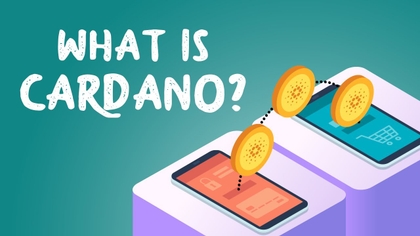

What is Cardano?
We first need to address the core question - what is Cardano? Let's continue with the story I’ve started telling in the introduction.
The initial team behind Ethereum broke up because of a conflict of interest. Vitalik wanted Ethereum to remain a non-profit project, while team members such as Charles had the opposite point of view - he wanted Ethereum to start accepting venture capital, and to become a for-profit project.
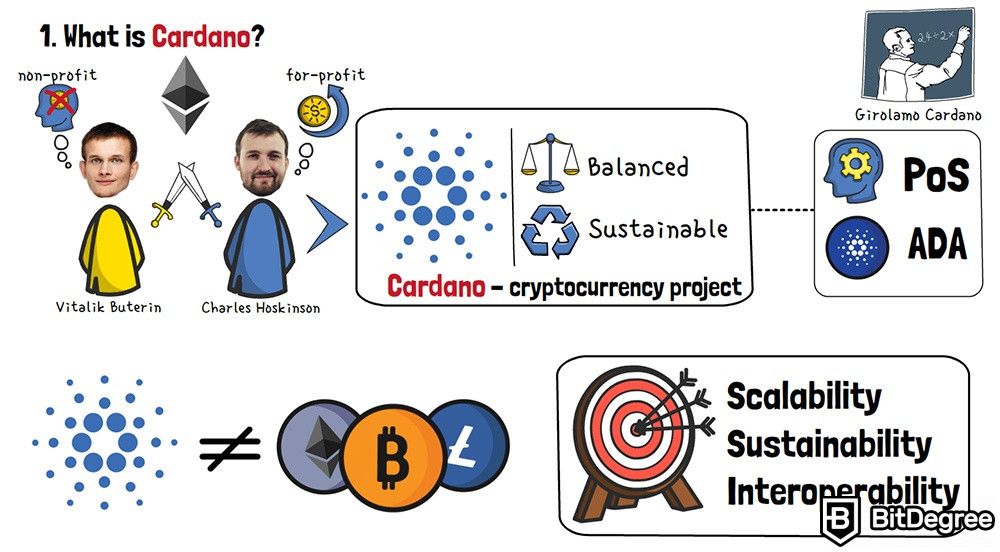
Charles Hoskinson created Cardano with a single goal - to provide a more balanced and sustainable ecosystem for the cryptocurrency world. At its very core, Cardano is simply a cryptocurrency project named after an Italian mathematician - just like many other crypto projects, it utilizes the Proof-of-Stake consensus algorithm (more on that later) and has a native coin called ADA.
This is like you and your friend building a sandcastle on the beach, and having an argument on how many towers it should have. Since you can’t come to a resolution, your friend decides to build a separate castle of his own - one with as many towers and gateways as he wants!
The thing that makes Cardano special, and also different from other, similar blockchains, is the goal that the project has. There are three problems that Cardano aims to solve, in regard to the crypto world - scalability, sustainability, and also interoperability.
Big terms, but don’t worry - let’s break each of them down, in a simple manner!
Scalability
Scalability is often named the biggest problem that all cryptocurrencies face. Put simply, it references the inability of blockchains to keep up with a growing userbase, transaction speed-wise.
Here’s a simple example for you to understand what I’m talking about:
Imagine that you’re using traditional banking methods to pay for your online shopping - let’s say, you have VISA. Your transactions are processed pretty fast, since VISA can handle up to around 24,000 different transactions per second.
However, every once in a while, you might experience lag spikes, if the network is encumbered - if there are tens of thousands of other people buying something at that point in time, using VISA, you might need to wait for a few minutes for your transaction to be approved.
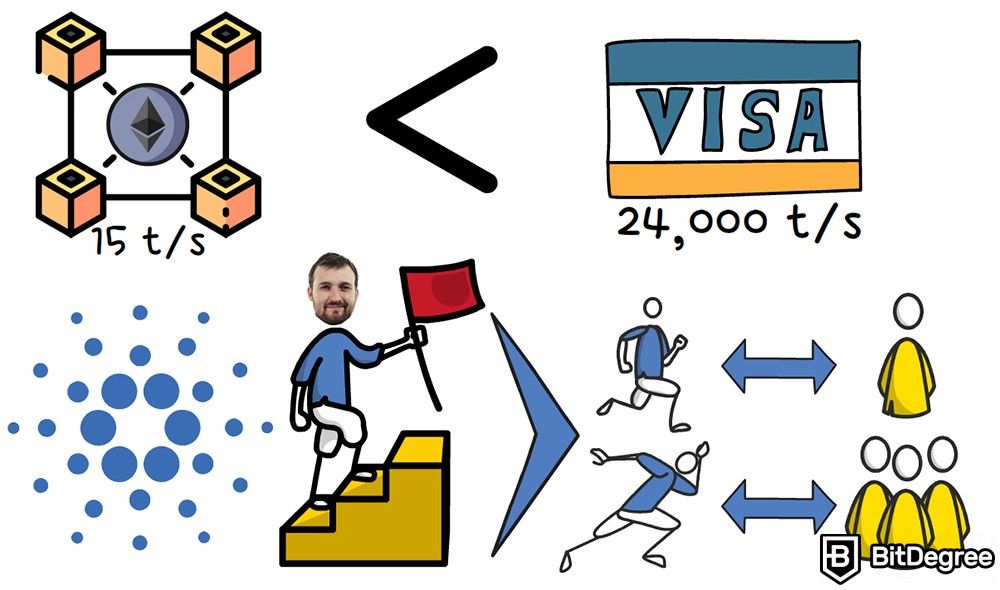
Blockchains experience the same issue. However, they also have notoriously small block sizes - in other words, many of the older blockchains can’t handle even close to the number of transactions that VISA can, per second. Ethereum is no exception - it can only deal with around 15 transactions per second!
So, Cardano aims to address and solve this problem. Specifically, the plan that Charles and the team behind Cardano have to make it like this: the more users join the network, the faster it gets.
Sounds awesome, doesn’t it? However, how is this achieved?
Well, as I’ve mentioned earlier, Cardano works on a Proof-of-Stake consensus algorithm. It’s a ginormous topic, of its own, so I highly advise you to go check out a section on staking if you want to understand it better.
For the sake of keeping things simple, basically, the Cardano network has validators (individual people, or organizations) that confirm transactions happening on the blockchain. The thing that makes Cardano different from other PoS networks, however, is Ouroboros.
This is a special type of system made up of epochs (currently, these are periods of 5 days) and slots (1-second intervals). Each slot has a slot leader (who is selected from the transaction validators), and this leader is chosen to confirm transactions.

All of that is, admittedly, extremely technical. I won’t be going deeper into the topic, since it’s so vast, that it requires a different section, of its own. For now, suffice to say that the Ouroboros system allows for the Cardano network to be much more secure than your traditional Proof-of-Stake blockchains, which then allows an increase in scalability.
Sustainability
Having dealt with that complicated can of worms, let’s move on to something that’s much simpler to understand - sustainability.
In terms of Cardano (and cryptocurrencies, in general), this means two things - how eco-friendly a project is, and just how likely it is to prosper and maintain its functionality, long-term.
Ecology-wise, Cardano’s Proof-of-Stake system allows it to be much more eco-friendly than cryptocurrencies such as Bitcoin or Ethereum. While it’s still not ideal, Cardano is already leaping ahead of the two aforementioned coins, when it comes to energy preservation and ecology concerns.
Now, project longevity-wise, the situation is kind of the same, too. Cardano has a dedicated treasury - it’s filled up with transaction fees, and then those fees are paid out in the form of rewards to anyone who makes a meaningful impact on the ecosystem (developers, scientists, and so on).
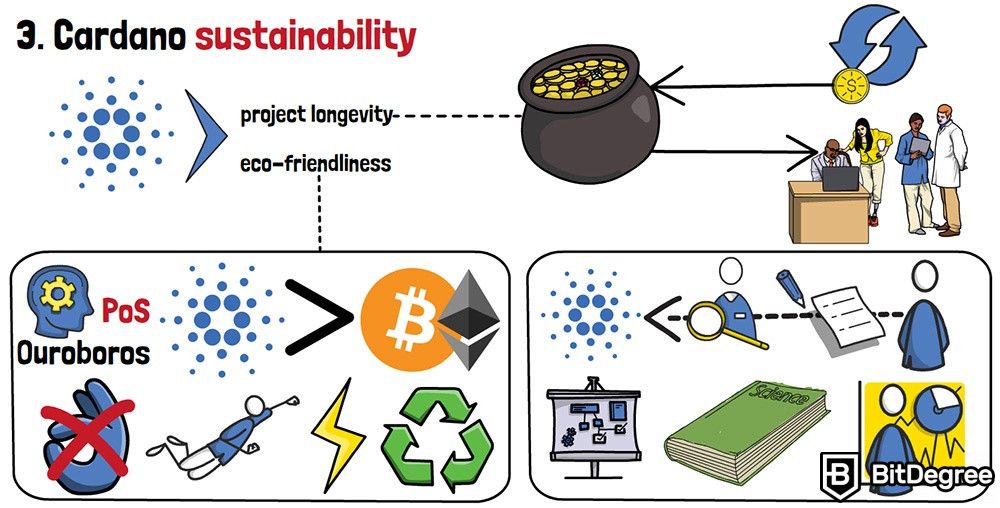
On top of that, Cardano is actually really big on science and long-term planning, in general. There’s a popular internet meme that, in order to make something happen on Cardano, you need to write a research paper on the subject, and have it peer-reviewed by other blockchain professionals. While it is funny, it does showcase that Cardano is purely based on scientific research and advanced maths!
Continuing on, at some point in time, Charles Hoskinson agreed on a collaboration with another co-founder of Ethereum, Jeremy Wood. This collaboration resulted in a brand new company, called IOHK (also known as Input-Output Hong Kong). Cardano is the main point of interest for IOHK, and the company itself is concerned with creating blockchain solutions for both private companies, as well as governmental institutions, worldwide!
All of that is to say - Cardano is already a well-established project, with multiple backers, a company standing behind it, and huge plans for the future. Charles himself hosts frequent livestreams on YouTube in order to answer questions that the community might have, and to talk about the future of all things Cardano.
Interoperability
Now, interoperability is another big issue that blockchains of today are dealing with. In order to understand what the term actually means, allow me to give you an example:
Imagine that you’re in a car, and are driving down a road. You’re going to check out another car - perhaps you want to buy it? Or maybe, simply meet a friend that drives a different car brand?
At some point in your journey, you come across a river that needs to be crossed. No matter if you drive a sports car, a truck, or a tractor, you won’t be able to cross that river without a bridge. Blockchain interoperability is that bridge!

To throw it back to our topic at hand, different blockchains need to have some sort of a “bridge” where they could communicate with each other. If a blockchain lacks interoperability, it means that it doesn’t have any cross-chain functionality, and you can only interact with it on its native projects and applications.
Cardano solves this issue with what is known as the “KMZ sidechains protocol”. It acts as that bridge between two blockchains - thanks to the protocol, users are able to trade Cardano coins (or, to be more specific, ADA coins) for other cryptocurrencies!
The Future of Cardano
So, then - up to this point, we’ve discussed what is Cardano, and how this blockchain network is different from most other cryptocurrency projects out there. As you might have figured out by now, it truly is special!
What does the future hold for Cardano, though? And what does the community think about it?
Well, for starters, it’s worth pointing out that Cardano has a really, REALLY strong community behind it. On one hand, this is amazing - it means that the project is strong and healthy, and that there’s avid interest in it, from a large number of people.
On the flip side, though, it’s also worth mentioning that there are criticisms of Cardano that relate to this very fact. Some people claim that the project has basically become a Charles Hoskinson cult, with fans cheering every single word that he says.
Furthermore, this then evolves into criticism that any progress made on the network developments is very slow, and that there are only unrealistic ideas being thrown around, without any signs of them being successfully implemented.
What’s the reality, though?
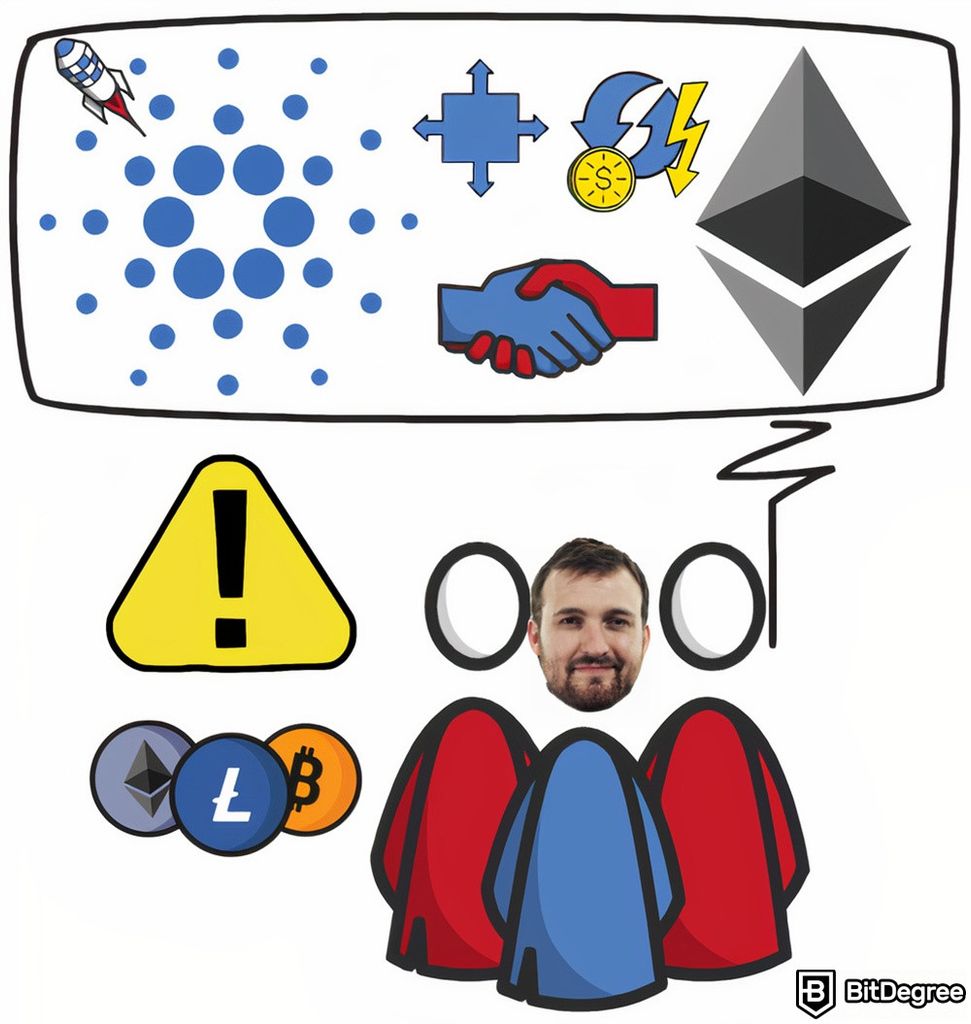
Well, Cardano seems to be truly an amazing project, with exponential potential! Sure, it does have some struggles, but this is true with any and all blockchains that you might evaluate and examine.
At the same time, it’s also important to mention that, contrary to popular belief, Cardano isn’t an “enemy” of Ethereum. Instead, Charles has expressed, multiple times, that he feels that blockchains should work together in order to build “a better tomorrow”, and not “muscle up” against each other, on which of them has better scalability or smaller transaction fees.
That being said, I do also have to point out that Cardano and Ethereum are still very different from one another. While Ethereum is often praised as the “core technology behind the development of Web 3.0”, Cardano aims to work with governments and large organizations that are concerned with “managing identity, value, and governance” (as pointed out by Charles himself).
With all of that being said, if you wish to learn more about the world of crypto make sure to check out the section about Web 3.0.










